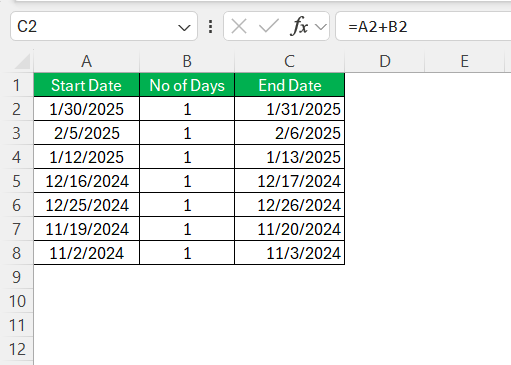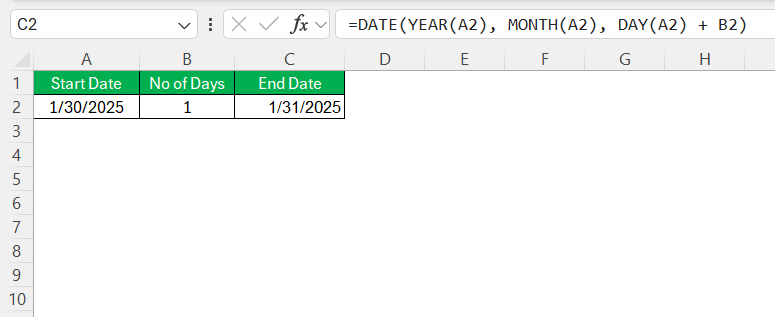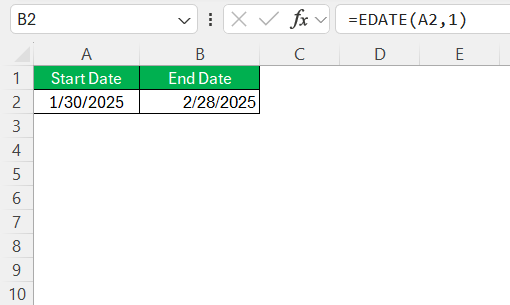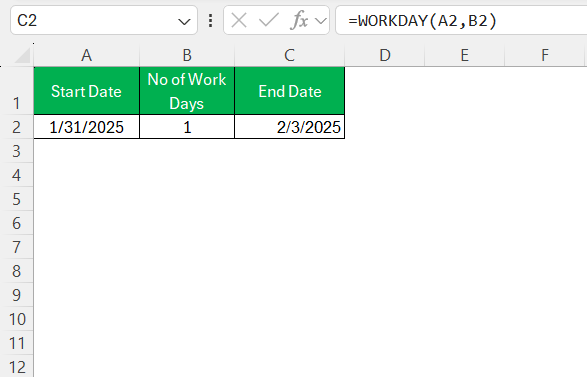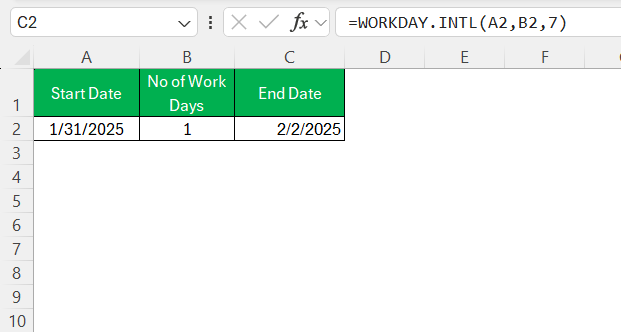When working with dates in Excel, I often need to adjust them by adding or subtracting days. Fortunately, Excel makes it incredibly simple to add a day (or multiple days) to a date using basic formulas. In this guide, I’ll walk you through the different methods I use to add a day to a date in Excel.
Key Takeaways:
- Adding days to dates in Excel is simple using basic formulas like
=A2+1or=A2+B2. - Functions like WORKDAY and WORKDAY.INTL helps exclude weekends and holidays for precise scheduling.
- The DATE function allows dynamic date manipulation by modifying the day, month, or year components.
- Advanced functions like EDATE and NETWORKDAYS improve business calculations for deadlines and financial planning.
- Proper date formatting ensures accurate results and prevents errors when working with Excel date calculations.
Table of Contents
Unlocking the Power of Dates in Excel
The Significance of Managing Dates in Spreadsheets
Dates are the backbone of any data-driven process, and in Excel, they are just as critical as numbers. Proper management of dates in spreadsheets can lead to a more organized, accurate, and efficient workflow. When dates are well-managed, it allows me to conduct time-sensitive analyses with ease, forecast outcomes more precisely, and maintain a clear record of past, present, and future events.
Moreover, in a business context, precise date management can be the difference between meeting a deadline and falling behind schedule.
Common Scenarios for Adding Days to Dates
In the vast landscape of Excel use cases, adding days to a date is a common and versatile operation. For instance, project managers often need to calculate an expected completion date by adding a task’s duration to its start date. Similarly, in finance, you might extend a payment deadline by factoring in grace periods. In healthcare, calculating patient follow-up dates is crucial, and in manufacturing, determining product expiration dates ensures quality control. These are just a few scenarios where adding days to dates becomes indispensable.
Moreover, anyone tracking important life events, like planning a vacation or counting down to a significant occasion, will find this skill useful. Being adept at date manipulation in Excel helps turn static data into dynamic plans and forecasts, making it essential for both professional and personal organizations.
Basic Techniques to Add a Day to a Date
Utilizing the Simple Addition Method
Using the simple addition method to add days to a date in Excel is straightforward. For instance, if you have a start date in cell A2 and you want to add a certain number of days located in cell B2, the formula =A2+B2 does the trick. As you drag the formula down, it adds the respective days in column C to each date in column B, updating the results in the cell where you entered the formula.
It’s an effective technique when dealing with a series of dates and corresponding days to add—a real timesaver in situations where quick date calculations are needed.
However, remember that since dates are serial numbers in Excel, this method relies on the underlying numerical representation of dates. Therefore, to prevent any errors, always ensure that the cells containing dates are appropriately formatted before performing the addition. Simple but powerful, this method is often my first tool of choice for straightforward date addition tasks.
Leveraging Excel’s Date Functions for Precision
Excel’s date functions offer precision when adding days to dates is critical. The DATE function, for instance, allows the creation of a date from individual year, month, and day components, making it perfect for constructing specific dates. To add days, I can use the DATE function in combination with the DAY function, like so: =DATE(YEAR(A2), MONTH(A2), DAY(A2) + B2), replacing A2 with the original date and B2 with the number of days to add.
Using these functions also helps ensure that the data integrity stays intact, even when dates need to be recalculated due to changes in plans or data entry errors. Excel’s date functions are my go-to tools for ensuring date calculations are not only precise but adaptable to any changes that may come my way.
Advanced Tactics for Date Manipulation
Working with the EDATE and WORKDAY Functions
The EDATE and WORKDAY functions are advanced tools in Excel designed for sophisticated date manipulation. EDATE elegantly handles month-based calculations; for example, to add exactly one month to a date in cell A2, I can write =EDATE(A2, 1).
This function automatically corrects for differing month lengths, ensuring a consistent month-to-month addition.
On the other hand, WORKDAY is invaluable for finding a date a certain number of business days in the future or past, considering only workdays and excluding weekends. To calculate this, I use =WORKDAY(A2, B2), which tells me the date after adding B2 workdays to the date in A2.
If I have a list of holidays that should be excluded, I can add it as a range in the third argument of the function.
Both EDATE and WORKDAY save time and add a level of detail that the simple addition method cannot, making them indispensable for tasks like setting deadlines, scheduling payments, and other business-related date calculations where precision is paramount.
Each function caters to different needs: EDATE helps me project dates based on a monthly cycle, while WORKDAY keeps business routines running smoothly by factoring in workweek patterns and holidays. No matter the scenario, these functions have proven themselves time and again in my Excel toolkit.
Dealing with Weekends and Holidays Effectively
When working with dates, it’s crucial to account for weekends and holidays, and Excel comes equipped to handle these with finesse using functions like WORKDAY and WORKDAY.INTL. The WORKDAY function allows me to compute a future date by adding business days to a start date, excluding standard weekends (Saturday and Sunday). It becomes especially powerful when used with a range of dates that should be treated as holidays, which are then excluded from the business days calculation.
For varied weekend configurations, WORKDAY.INTL gives me flexibility by letting me define which days should be considered weekends. For example, in some Middle Eastern countries, the weekend might be Friday and Saturday instead of Saturday and Sunday.
This function accounts for those differences, ensuring my date calculations remain relevant and accurate regardless of regional workweek variations.
By utilizing these functions, I avoid the complexity and potential inaccuracies that can arise from manually calculating business days. Whether it’s for generating reports, defining project timelines, or scheduling staff shifts, Excel’s capabilities in handling weekends and holidays save me time and increase the reliability of my date-related functions.
Ultimately, these functions give me and other Excel users peace of mind when planning around variable work schedules and public holidays, making them a cornerstone for any task where date authenticity is a priority.
Everyday Applications of Date Addition in Excel
Project Management and Deadline Tracking
Project management thrives on accurate deadline tracking, a forte of Excel’s date functions. In my experience, by using functions such as WORKDAY and NETWORKDAYS, I can forecast end dates of projects by adding the number of expected working days to the start date, or count the actual days worked between two dates. This is particularly useful for project managers who need to navigate through complex timelines and ensure that deliverables are on track.
For example, it’s often my task to determine a project’s end date, taking into consideration not just the duration, but also weekends and holidays. This is where WORKDAY shines, as it allows me to specify a start date and add the number of working days to find the completion date, while seamlessly skipping over any non-working days that I’ve outlined.
Financial planning also benefits from precise deadline tracking. Whether it’s for estimating cash flow based on payment deadlines or scheduling financial reports, I utilize Excel to manage dates efficiently, minimizing errors and ensuring important deadlines are met.
With these functions at my disposal, I can provide stakeholders with a clear picture of project timelines, enhance transparency, and contribute to the overall success of my projects by keeping everyone aligned on key dates. Excel’s date manipulation capabilities are, without a doubt, pivotal in streamlining project management and deadline-tracking endeavors.
Financial Planning and Analysis
In financial planning and analysis, the ability to project and track dates is tantamount to accuracy and foresight. Excel’s date functions aid me in a myriad of tasks such as calculating maturity dates for investments, setting budget review periods, and forecasting quarterly financial trends. By incorporating functions like EDATE for adding months or WORKDAY for business day calculations, I ensure that financial models reflect the reality of market operations where holidays and weekends impact trading and payment dates.
For instance, when analyzing cash flow, it’s imperative to align receivables and payables with the expected dates. This is where Excel helps me pinpoint the exact dates when the cash movement should occur, accounting for weekends and holidays which could affect liquidity if not properly managed.
Another example is when I’m tasked to determine the future value of an investment taking into account the exact dates of compound interest application. Excel streamlines this process, allowing me to focus on the financial analysis rather than the mechanics of date calculation.
Excel proves to be an indispensable tool that blends seamlessly into the fabric of financial planning and analysis. It enhances the precision of forecasts, ensures alignment with real-world conditions, and, most importantly, enables me to make data-driven decisions with confidence.
FAQs
Q1. What is the simplest way to add a day to a date in Excel?
The simplest way to add a day to a date in Excel is by using basic addition. Type “=B5+1” into a cell, replacing B5 with the cell reference that contains the date you want to add a day to. Excel will then calculate the new date with the day added.
Q2. How do you account for weekends when you add a day to a date in Excel?
To account for weekends when adding days to dates in Excel, use the WORKDAY function. For example, “=WORKDAY(A1, 10)” adds 10 business days to the date in cell A1, excluding weekends. For customized weekends, WORKDAY.INTL allows you to specify which days are weekends.
Q3. How do I increment a date by day in Excel?
To increment a date by a day in Excel, simply add 1 to the cell containing the date. You can do this by typing the formula “=A2+1” into a cell, where A2 is the cell with the original date. Excel treats dates as serial numbers, so adding 1 increments the date by one day.
Q4. .How do we subtract two dates to find the difference in days?
To find the difference in days between two dates in Excel, subtract the earlier date from the later date. Enter “=B2-A2” in a cell, where B2 is the end date and A2 is the start date. This will give you the number of days between the two dates.
Q5 .How to format the result of date subtraction to display as a specific date format?
To format the result of date subtraction to display as a date, first ensure you’re not subtracting two actual date values but rather finding the difference in days. Then, right-click the cell, choose “Format cells,” select the desired date format under the Number tab, and click OK. If the result is a duration and not a date, format it as a number instead.
John Michaloudis is a former accountant and finance analyst at General Electric, a Microsoft MVP since 2020, an Amazon #1 bestselling author of 4 Microsoft Excel books and teacher of Microsoft Excel & Office over at his flagship MyExcelOnline Academy Online Course.

